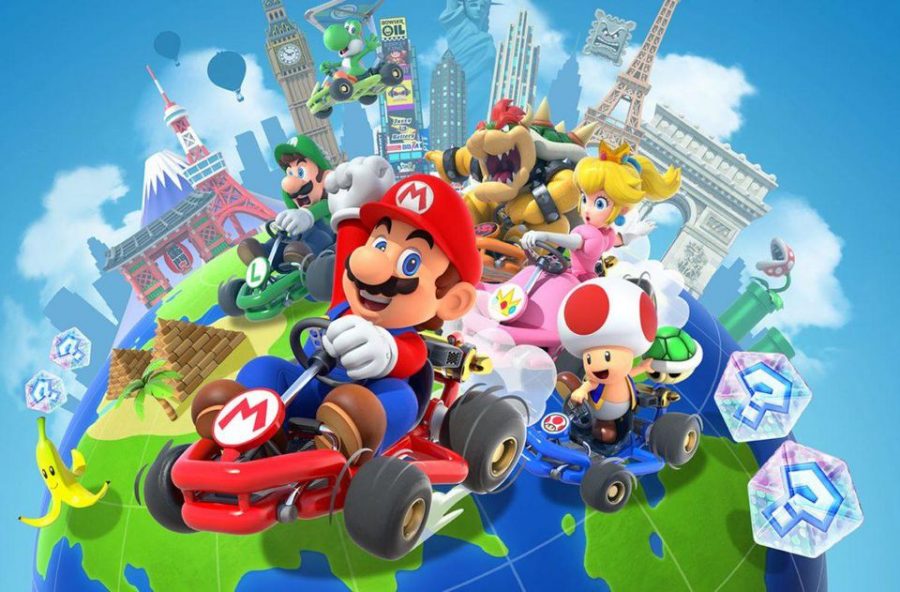Before being released on iOS and Android app stores, Mario Kart Tour offered a period of pre-order that helped build anticipation.
Mario Kart Tour: Nintendo strikes mobile gold, misses clear opportunities
October 3, 2019
After a rough few years on the mobile gaming market, a mustached plumber driving a mushroom-shaped automobile helped Nintendo burst into first place like a mighty blue shell.
“Pokémon Go” was a phenomenon – it seemed that the world halted its tracks to pick up their phone and travel around their own backyard in the search of pixelated animals to grow their collections. The reason “Pokémon Go” succeeded was simple: Nintendo and Niantic took a world-famous game franchise, put it in pockets all across the globe and relaxed under their Poké Ball-shaped umbrella to watch loads of money from microtransactions line their wallets. “Pokémon Go” was thought to be a one-hit-wonder, as Nintendo’s other mobile expeditions proved to be completely inadequate in comparison. However, falling from the Rainbow Road and landing on the top charts of app stores across the world is Nintendo’s latest endeavor: “Mario Kart Tour.”
Launching last week to a host of server maintenance issues, “Mario Kart Tour” skidded onto both iOS and Android, allowing players to compete against their friends as their favorite Mario characters – sort of. The “Mario Kart Tour” launch feels more like beta testing of a near-complete game than the worldwide launch of a global phenomenon a la “Pokémon Go.” It shows the underlying issue that exists within the game: the extraordinary amount of potential that is missed by the game in its current state.
“Mario Kart Tour” takes the fundamentals of current free-to-play games out there; players earn rubies to shoot characters out of a pipe, similar to how loot boxes work in other games, with the player having the ability to purchase these rubies with physical money or through hours and hours of grinding out the game.
In this take on the classic franchise, players race through various cups in order to increase their score on the leaderboard, with the goal of rising above their fellow randomly-selected challengers and move up tiers. Tiers almost act as a ranking system within the game to keep the playing field (or race track) as smooth and even as possible, with the highest-ranking players among each tour receiving a variety of rewards.
Every few weeks, “Mario Kart Tour” will change its selection of cups and tracks by implementing a new tour. For example, the current tour is based on New York City, allowing players to drift and dash their way around scenic areas of the Big Apple.
Each character, kart and glider, which are used in the air after flying off a special booster, has unique perks, be it a faster start at the beginning of the map or a greater chance to roll a certain type of item after hitting one of the item boxes littering the track. Furthermore, each track has a unique combination of character, kart and glider designed to give players a bonus for using that specific combination.
Nintendo also has a paid-subscription service called the “Gold Pass” that allows players to earn special rewards through play and race in 200cc, which is essentially the games ultra-hard mode.
Additionally, you can share friend codes with other players to compare your racing skills to theirs, though there is no monetary reward like tiers, and unfortunately, that’s where the potholes with “Mario Kart Tour” begin to show. See, in the current state of the game, players are not actively racing against real-life players, they are just racing against bots that compete on a basis according to whatever ‘cc’ you choose, be it 50cc, 100cc or 150cc. With multiplayer ‘inbound’ according to Nintendo, it leaves players with a false sense of community that has yet to be implemented into the game yet.
The game has so much promise, being one of the best-racing franchises of all time and being readily accessible to essentially everyone and their mother, but the fact that “Mario Kart Tour” launched without multiplayer, which has always been a fundamental part of the series, is worrisome. Not to mention the fact that the game suffers from some poor level design. While the tracks and character models look beautiful and were masterfully scaled down to fit the portrait-oriented smartphone, they suffer from some rather poor mistakes. For example, you could take a shortcut on a track, which rewards the players by way of points, only to be launched into a hole in the map and forced to lose your spot in the increasingly fast race going on around you.
The fact of the matter is this: “Mario Kart Tour” is fun. Like, very fun. Competing against my friends to try to best them on the leaderboard instilled in me a sense of competition that I haven’t felt in a while. However, Nintendo clearly missed the mark on multiplayer and the game itself suffers from some questionable design choices and pay-to-win systems. Give it a test ride; it’s a fun ride whenever Nintendo dodges the banana peel that they threw in front of themselves.

NotBot • Nov 18, 2019 at 9:08 pm
What should I play next after have done with fireboy and watergirl on hudgames?